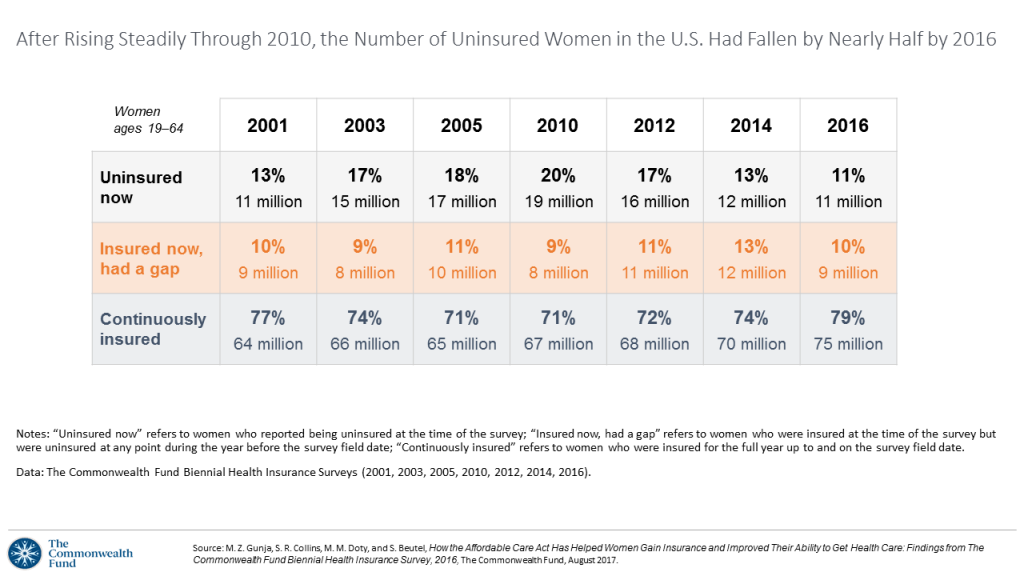
The Affordable Care Act (ACT) was implemented in 2010. Since the inception of the ACA, the proportion of uninsured women in the U.S. fell by nearly one-half, from 19 million in 2010 to 11 million in 2016.
The Commonwealth Fund has documented the healthcare gains that American women made since the ACA launch in their issue brief, How the Affordable Care Act Has Helped Women Gain Insurance and Improved Their Ability to Get Health Care, published earlier this month.
The first chart talks about insurance: health care plan coverage, which is the prime raison d’être of the ACA.
It’s especially noteworthy that women with low incomes made gains in coverage across racial and ethnic groups. In 2010,
- 25% of Black women were uninsured and earned less than 200% of the Federal Poverty Level; by 2016, that number fell to 16%
- 49% of Latina women were uninsured and earned less than 200% FPL, falling to 32% in 2016
- For white women, 31% were uninsured in 2010 with incomes less than 200% FPL, dropping to 12% in 2016.
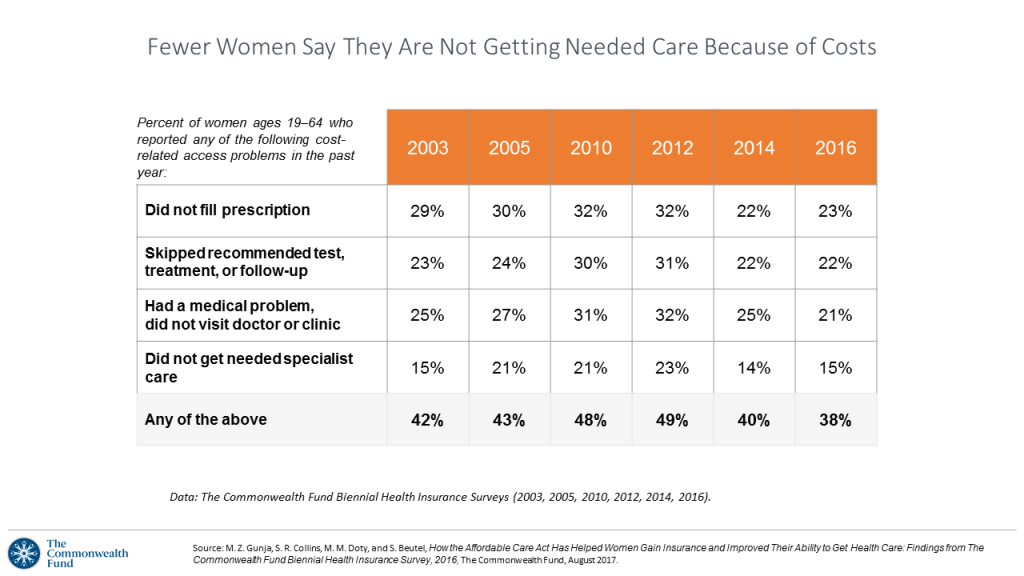
The ACA made it easier for women to buy health plans on their own, The Fund found. In 2010, one-third of women who had health insurance or tried to buy it in the individual market in the past three years had either been turned down by an insurance company, charged a higher premium due to pre-existing conditions, or been excluded due to a specific health problem. Fewer than half of the women (46%) who tried to buy health insurance finally enrolled in one.
By 2016, 67^ of women shopped for a plan in the individual market and finally enrolled in one, with the percentage of women having difficulty finding an affordable plan dropping by half. Women with existing health problems made especially large gains, The Fund learned.
The proportion of women skipping or delaying medical care because of cost also fell. These self-rationing issues included not filling a prescription for medicine, not seeing a specialist when needed, skipping a recommended test or treatment, and not seeing a doctor when sick. The share of women reporting a cost-related problem getting care fell from 48% in 2010 to 38% in 2016, shown in the second chart.
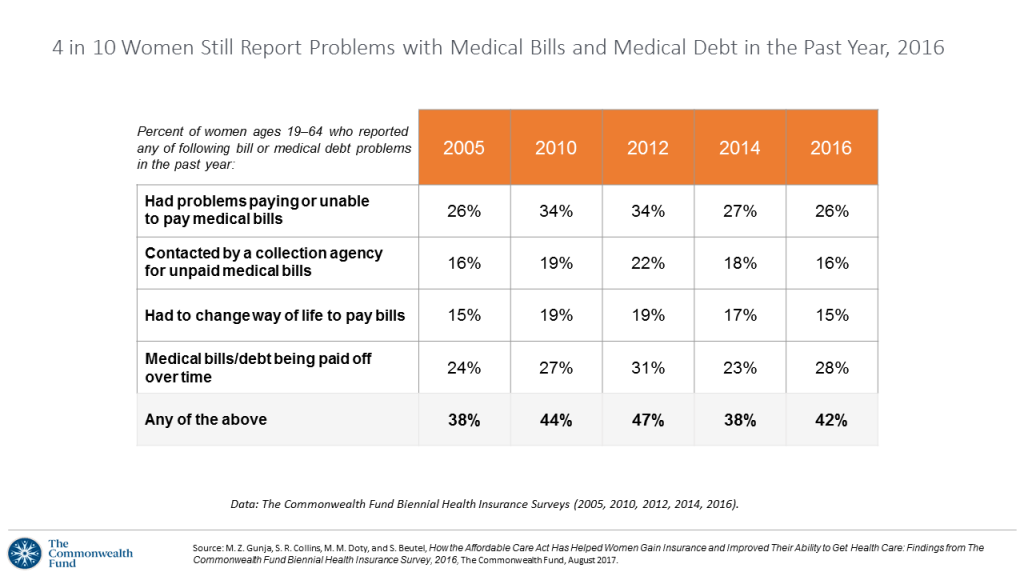
Health Populi’s Hot Points: It’s very good news that women’s access to healthcare has significantly improved since the implementation of the Affordable Care Act. But the costs of health care services continue to motivate self-rationing of care due to costs, with 4 in 10 women reporting problems with medical bills and mounting medical debt in 2016, the third chart attests.
Not filling prescriptions, skipping needed lab and diagnostic tests, and avoiding seeing the doctor to avoid the out-of-pocket costs feel like short-term rational fiscal decisions. However, these can lead to downstream negative physical outcomes and resulting greater medical costs. This can then perpetuate a cycle of downward financial health, on top of sub-optimal health outcomes.
Women are more likely than men to say they are paying off medical debt over time, Kaiser Family Foundation found in a 2016 survey.
The societal cost is greater burden on social and public sector safety net budgets (e.g., SNAP benefits, Medicaid, disability payments, and so on). For women, who play the role as caregiver for children, parents, and self, the burden is heavy especially for those managing chronic conditions like heart disease, diabetes, and the mental health impacts of everyday stress.
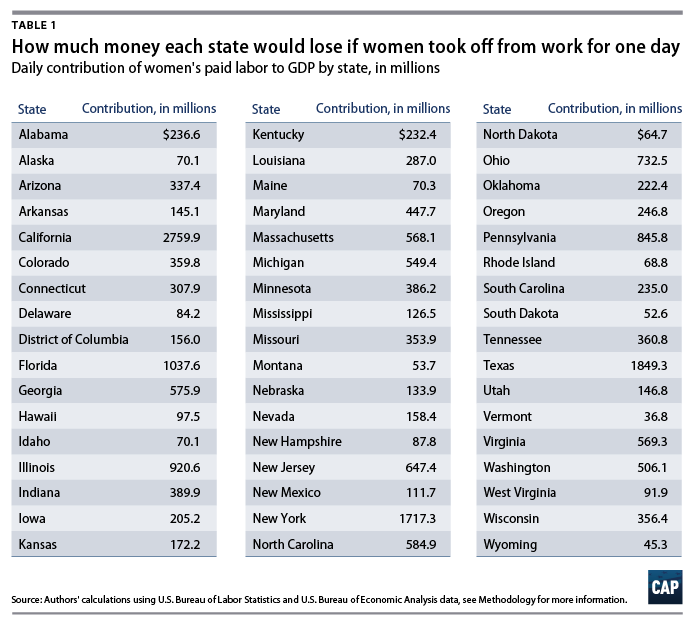 What would a day in America without women’s economic contributions look like? The Center for American Progress asked that question this year on International Women’s Day, March 8. The fourth chart quantifies the answer, by U.S. state, for how much money each state would lose if women took off work for one day.
What would a day in America without women’s economic contributions look like? The Center for American Progress asked that question this year on International Women’s Day, March 8. The fourth chart quantifies the answer, by U.S. state, for how much money each state would lose if women took off work for one day.
These calculations are under-estimates, however. The methodology here doesn’t take into account that women tend to take on unpaid labor, spending 150% more time on housework than men and more than twice the time men spend on caregiving. These skills are vital to the macroeconomy.
Access to health care services is a social determinant of health, and of a healthy national economy.


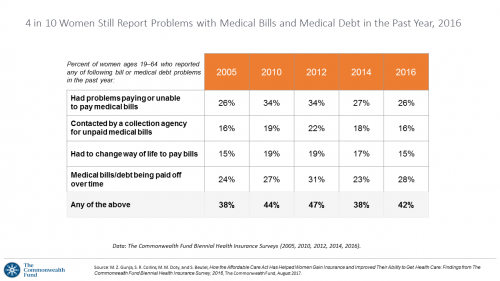


 Interviewed live on BNN Bloomberg (Canada) on the market for GLP-1 drugs for weight loss and their impact on both the health care system and consumer goods and services -- notably, food, nutrition, retail health, gyms, and other sectors.
Interviewed live on BNN Bloomberg (Canada) on the market for GLP-1 drugs for weight loss and their impact on both the health care system and consumer goods and services -- notably, food, nutrition, retail health, gyms, and other sectors. Thank you, Feedspot, for
Thank you, Feedspot, for  As you may know, I have been splitting work- and living-time between the U.S. and the E.U., most recently living in and working from Brussels. In the month of September 2024, I'll be splitting time between London and other parts of the U.K., and Italy where I'll be working with clients on consumer health, self-care and home care focused on food-as-medicine, digital health, business and scenario planning for the future...
As you may know, I have been splitting work- and living-time between the U.S. and the E.U., most recently living in and working from Brussels. In the month of September 2024, I'll be splitting time between London and other parts of the U.K., and Italy where I'll be working with clients on consumer health, self-care and home care focused on food-as-medicine, digital health, business and scenario planning for the future...